Banked Curves
(Circular Motion, Free Body Diagrams, Kinematics and the Physiological Effects)
Coaster Design Home Page
HORIZONTAL CURVES AND TURNS
A horizontal curve is a curve that does not rise or fall. There are two type of curves, flat curves and banked curves.
FLAT CURVES
A flat curve gives a rider the sensation of being thrown sideways. If the roller coaster car’s velocity is fast enough and the radius small enough, the stresses on the car’s under carriage can be tremendous. For a flat curve the inward net acceleration felt by the rider is calculated from the equation.

Where “a” is the acceleration felt by the rider to the inside of the circle, “v” is the velocity of the car and “R” is the radius of the curve. This acceleration can be converted to g’s by dividing it by 9.80 m/s2.
| Example 1 |
| A car travels around a flat curve at 20 m/s. If the curve has a radius of 13.61, then how many g's does the rider feel? |
Solution
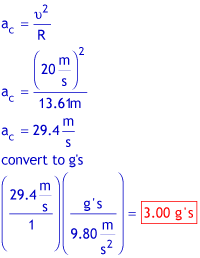
|
BANKED CURVES
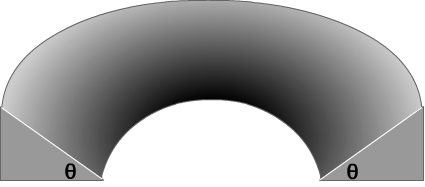
A banked curve reduces the rider’s sensation of being thrown sideways by turning the car sideways. The car is tilted. The trick is to tilt the track just the right amount.
The ideal banked curve is one where no outside forces are needed to keep the car on the track. In other words, if the banked curve were covered with ice -no friction- and the coaster did not have a steering mechanism the car would stay on the track. This is the ideal banked curve. These are the forces acting on the car as the car travels around horizontal banked curves.
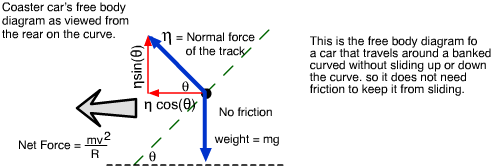
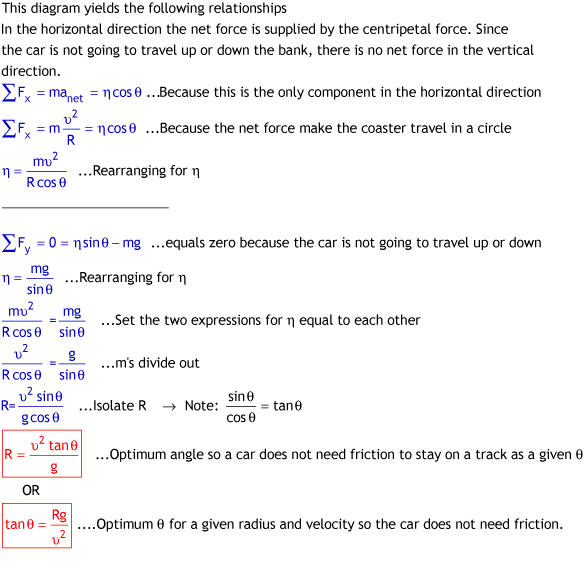
This is for the ideal banked curve where no friction is required to keep the car from sliding to the outside or inside of the curve. R is the curves radius; v is the car's velocity; g is the acceleratin due to gravity, nad the angle is the angle with the horizontal as shown in the diagram. On a given curve if the velocity is greater or less than the design velocity then the cars may need a little frictional help to keep them on the track.
If your not comfortable with trigonometry functions, the equations can be rewritten and used as shown below.
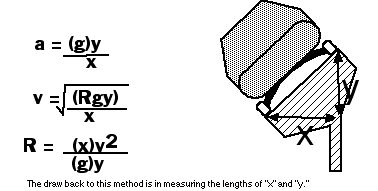
Calculating g’s Felt on a Banked Curve
The rider will feel a combination of the force pulling down due to gravity and the sideways force of the track propelling the rider to the center of the circle. Recall that the g’s felt is equal to the normal force divided by mass to get the acceleration and then divided by g to convert to from m/s2 to g’s.
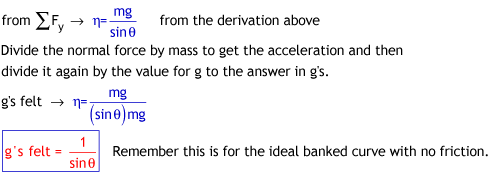
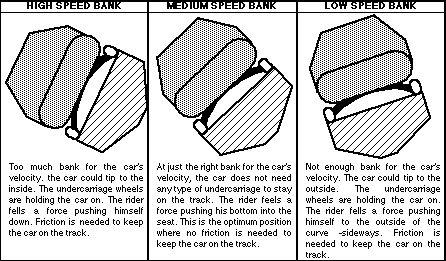
| Example 2 |
A car travels 22 m/s around curve of radius 75 m so it does not need friction to complete the curve.
(a)
What is the angle of the bank on the curve?
(b) How many g's are felt by the rider on the curve?
|
Solution
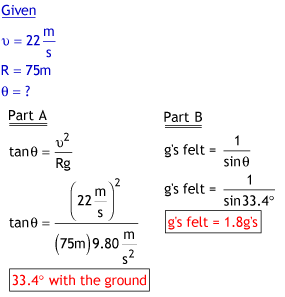
|
| Example 3 |
| Design a banked curve where the passenger feels 3.5 g's while traveling at 52 m/s. |
Solution
Strategy: Find the bank angle and then calculate the radius of the track.
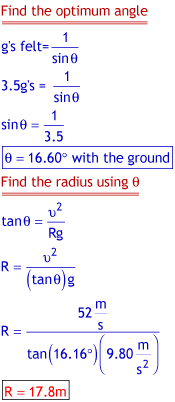
|
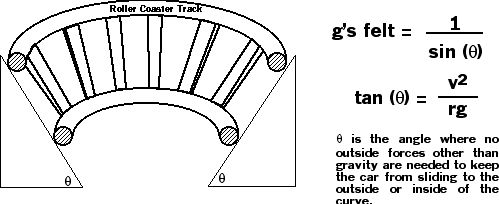
1 What must the curve’s angle be for a roller coaster car to travel around a curve of radius 30 m at 20 m/s?
2 How many g’s are felt by a rider as he travels around the banked curve in the previous problem?
3 A car is to make it around a banked curve. The radius is 15.35 m and the car will travel at 30 m/s. What is the optimum banking angle of the curve?
4 A car is to make it around a banked curve. The radius is 15.35 m and the car will travel at 30 m/s. This roller coaster is on the moon where the acceleration due to gravity is 1.67 m/s2. What is the optimum banking angle of the curve?
5 A rider is to make it around a curve of radius of 24.28 m so that the rider will feel 2.50 g’s. What is the angle of the banked curve?
6 A rider is to make it around a curve of radius of 31.15 m so that the rider will feel 1.64 g’s. How fast must the rider be traveling?
7 A rider is to make it around a curve of radius of 51.15 m so that the rider will feel 4.52 g’s. How fast must the rider be traveling?
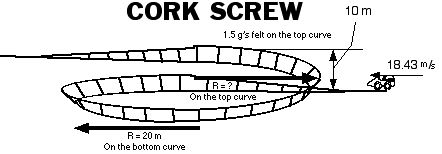
8 What is the banked angle of the bottom curve?
9 How many g’s are felt by the rider along the bottom curve?
10 What is the optimum angle of the top banked curve after spiraling up 10 m?
11 What is the radius of the top curve?
ANSWERS
1 53.68° 2 1.69 g’s 3 80.51° 4 88.37°
5 66.42° 6 19.92 m/s (52.69°) 7 47.01 m/s (77.22°) 8 60.01°
9 2.000 g’s 10 48.19° 11 13.11m (11.99 m/s at the top)
|